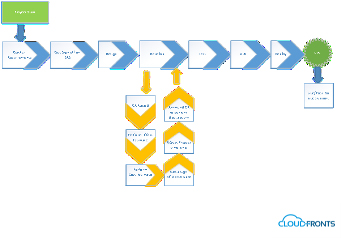Project methodology to run a mid-size CRM Project successfully
A CRM project of 3 to 6 months’ time is a good medium sized project, a medium scale organization looks for. It allows them to do proper resource allocation and extend their horizon to showcase their talent to bring out the best from the venture. But, this needs to be handled well with a full time PM dedicated for the project. Along with this the entire project cycle has to be ethically followed.
Below is a step by step quick guide that can help a successful CRM Implementation for such projects to be done.
1. Prepare a project proposal and get the Sign – off/Approval on the hours estimated for the bifurcated tasks from client.
2. Create a Project Charter to assign a Project Manager to the project.
3. Allocate the resources needed. Here we carefully do a right mix of senior resources vs junior resources to develop the project.
4. Once the above is fixed the PM needs to prepare a project plan. Allocate the resources at task level. (Use MS Project for creating project plan).
5. Get the environments ready to start the work. Ideally we need 3 environments for the entire project life cycle:
a. Dev Environment – Where developer carry there development activity.
b. UAT Environment – Where Client performs test for the development done.
c. Production Environment – Where the final product shall be deployed.
6. Since the development happens in Phases for a CRM project, we can follow “Agile Methodology” for development of CRM application.
Following are the phases in which the development is carried out:
1. Design Entities.
2. Design Views.
3. Design Forms.
4. Create users in CRM.
5. Assign Business Units and Security Roles to the users.
6. Write Scripts/Business logic.
7. Write Plug-in’s if required.
8. Write workflows.
9. Do any Third Party integration – If Required.
7. With the above phases defined we can split then into 4 phases.
Phase 1: (CRM Look and Feel)
> Design Entities.
> Design Views.
> Design Forms.
Phase 2: (User Security Roles & Business Unit)
> Create users in CRM.
> Assign Business Units and Security Roles to the users.
Phase 3: (Business Rules)
> Write Scripts/Business logic.
> Write Plug-in’s if required.
> Write workflows.
Phase 4: (Any Third Party Integration)
8. For all the 4 phases defined above schedule UAT’s as and when they are finished. They should be defined as milestones in the project.
9. Each phase should be minimum of 1 week’s duration, which includes bug fix if any. (Depending upon the complexity and size of the project). They should also be reflecting in the Project Plan.
10. With all of the above set follow the Project development methodology defined.

11. After we are done with the Requirement Gathering Phase of the project which might be a littles exhaustive as we need to have call with the client for more than 3 days a week.
12. Post the requirement gathering phase is complete and we are in actual development phase we need to do a couple of things in order to proceed:
a. Document the Function Requirements and prepare a “FRD (Functional Requirement Document)”.
b. Simultaneously with project development prepare a “TSD (Technical Specification document)”.
c. Schedule a bi-weekly call with the client to provide status update and also discuss on other requirements if any.
13. Ask the client to create User Test cases for all the entities. Hand over the same to us 1 week in advance before each phase is pushed to UAT.
14. After each Client meeting do make it a point to send out precise Minutes of meeting.
15. Every week once send a status update and work review report to the client.
16. At any point of time the project should have a following set of updated documents to refer to:
a. FRD – Attached with CR’s.
b. TSD
c. Project Plan (MS – Project)
d. One Note: This contains the following other project related information like
i. Environment Details/ Credentials.
ii. Agenda’s for each project meeting schedules.
iii. Minutes of Meeting.
iv. TO DO’s/ Tasks for the team.
e. Issue Tracker Sheet. (Shared with the client)
17. At the closure of the project we should have the following documented and preserved as companies knowledge base:
a. Learnings from project.
b. Issues/ Challenges faced.
